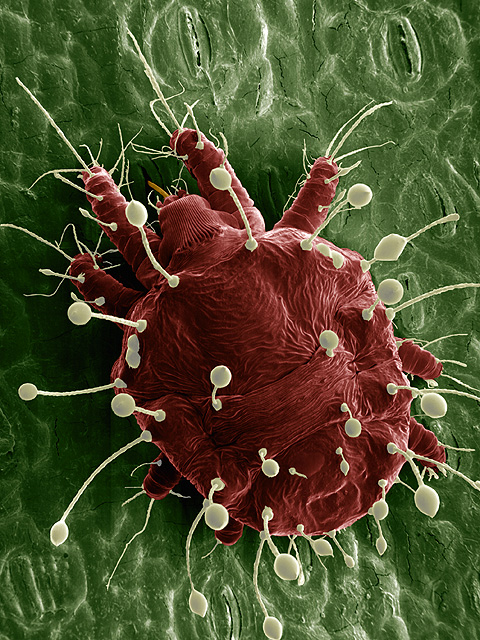
A tiny mite is creating a big stir in the western hemisphere's tropics, ie the Americas.
Scientists with the Agricultural Research Service (ARS) and the Animal and Plant Health Inspection Service (APHIS) have joined a multinational effort to stop the red palm mite, an invasive pest that rides the wind and, until now, was mainly known for attacking coconut palms in the Eastern Hemisphere's tropical and subtropical regions. Wind blown pests are known to arrive in north Australia each year, mainly small insect vectors critically involved in some animal diseases.
According to Ronald Ochoa, a mite expert at the ARS Systematic Entomology Laboratory in Beltsville, Md., the red palm mite has been found in the Caribbean region, including on U.S. soil in Puerto Rico and St. Thomas. The fast spread of this pest, which causes serious leaf damage, constitutes the biggest mite explosion ever observed in the Americas, according to Ochoa. He added that, in Trinidad, he and colleagues estimated there were 30 to 100 million mites per palm.
At stake may be more than just the health of sectors of the ornamental plants industry and the palm trees that are synonymous with the tropical lifestyle. On Dominica, the mite has attacked banana plants, and a grower in Trinidad indicated that he anticipates a 50 percent loss in coconut production on his property, according to Ochoa.
The red palm mite, Raoiella indica, was first described in 1924 in India, and identified in the Western Hemisphere three years ago on Martinique. Its calling cards include yellow-spotted or totally discolored palm leaves, and reddish-brown areas signaling mite clusters. In Australia this pest has been identified as a potential threat for cotton crops, especially close to palms, but the real threat is probably the ornamental palm industry itself, a major ornamental crop across northern Australia, and these palms are used widely in urban landscaping. It is hard to even imagine the overall damage to society across the north if a similar scale of problem to the Caribbean was seen in Australia.
It is probably time that at least in the north of Australia awareness of the problem in the US and Caribbean was made known and information about the pest provided to industry. North Australia already has Palm Leaf Beetle, which causes losses among many palms in the region.
USDA scientists have learned a great deal about the mite since being alerted to its presence by concerned officials representing several Caribbean nations. It's hoped that their studies will help lead to biological and chemical controls and a means of monitoring for new hosts of the mite.
Read more about the American research, an excellent overview of the Western Hemisphere situation, available online at:
http://www.ars.usda.gov/is/AR/archive/may07/island0507.htm
Scientists with the Agricultural Research Service (ARS) and the Animal and Plant Health Inspection Service (APHIS) have joined a multinational effort to stop the red palm mite, an invasive pest that rides the wind and, until now, was mainly known for attacking coconut palms in the Eastern Hemisphere's tropical and subtropical regions. Wind blown pests are known to arrive in north Australia each year, mainly small insect vectors critically involved in some animal diseases.
According to Ronald Ochoa, a mite expert at the ARS Systematic Entomology Laboratory in Beltsville, Md., the red palm mite has been found in the Caribbean region, including on U.S. soil in Puerto Rico and St. Thomas. The fast spread of this pest, which causes serious leaf damage, constitutes the biggest mite explosion ever observed in the Americas, according to Ochoa. He added that, in Trinidad, he and colleagues estimated there were 30 to 100 million mites per palm.
At stake may be more than just the health of sectors of the ornamental plants industry and the palm trees that are synonymous with the tropical lifestyle. On Dominica, the mite has attacked banana plants, and a grower in Trinidad indicated that he anticipates a 50 percent loss in coconut production on his property, according to Ochoa.
The red palm mite, Raoiella indica, was first described in 1924 in India, and identified in the Western Hemisphere three years ago on Martinique. Its calling cards include yellow-spotted or totally discolored palm leaves, and reddish-brown areas signaling mite clusters. In Australia this pest has been identified as a potential threat for cotton crops, especially close to palms, but the real threat is probably the ornamental palm industry itself, a major ornamental crop across northern Australia, and these palms are used widely in urban landscaping. It is hard to even imagine the overall damage to society across the north if a similar scale of problem to the Caribbean was seen in Australia.
It is probably time that at least in the north of Australia awareness of the problem in the US and Caribbean was made known and information about the pest provided to industry. North Australia already has Palm Leaf Beetle, which causes losses among many palms in the region.
USDA scientists have learned a great deal about the mite since being alerted to its presence by concerned officials representing several Caribbean nations. It's hoped that their studies will help lead to biological and chemical controls and a means of monitoring for new hosts of the mite.
Read more about the American research, an excellent overview of the Western Hemisphere situation, available online at:
http://www.ars.usda.gov/is/AR/archive/may07/island0507.htm
No comments:
Post a Comment